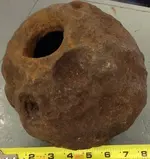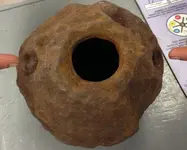Dug
Bronze Member
- Joined
- Feb 18, 2013
- Messages
- 1,138
- Reaction score
- 1,264
- Golden Thread
- 0
- Location
- SC Lowcountry
- Detector(s) used
- XP Deus/Sovereign GT.
- Primary Interest:
- Relic Hunting
Please help Cannonball guy.
A friend dug this out of a farm field near a civil war skirmish site in the SC Lowcountry. He brought it by my shop so I did impromptu pics with Iphone and tape and postal scale. Weighs 26.5 lbs but that is minus the inside charge and sections of the outside I'm guessing from elements and farm plows. The fuse hole is exactly 2 inches across. Something noted in the second pic is opposing notches near the fuse hole. Any help with the limited data I have for you?


A friend dug this out of a farm field near a civil war skirmish site in the SC Lowcountry. He brought it by my shop so I did impromptu pics with Iphone and tape and postal scale. Weighs 26.5 lbs but that is minus the inside charge and sections of the outside I'm guessing from elements and farm plows. The fuse hole is exactly 2 inches across. Something noted in the second pic is opposing notches near the fuse hole. Any help with the limited data I have for you?


Last edited:


